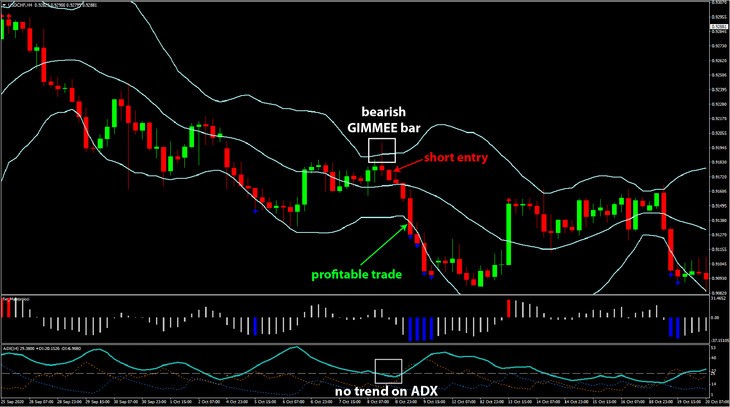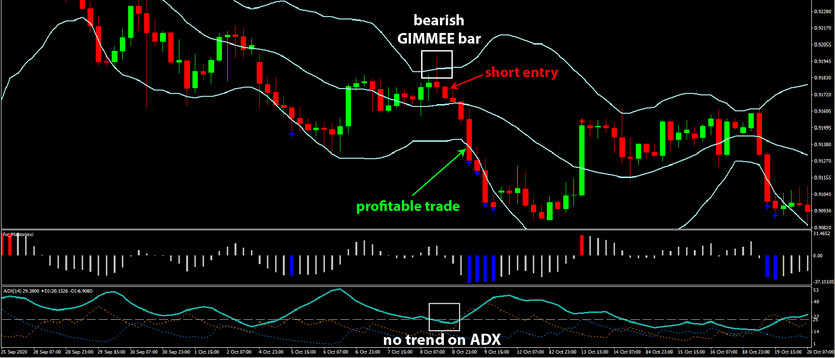GIMMEE bars are essentially a rejection type of price action but used only with the Bollinger Bands indicator. Thus, it indicates a reversal at either the top or bottom side of the Bollinger Band.
The GIMMEE trading system can be especially effective if used in conjunction with other indicators and tools like we are going to show below. Although it is not necessary to use these additional tools, they should help to increase the probabilities for making a profitable trade.
Indicators used:
· Bollinger Bands (standard settings)
· ADX
· FxTR Mastorsicci Divergence Indicator (free download here)
Strategy rules:
A GIMMEE bar is defined as one that pierces the upper or lower Bollinger Band but doesn’t break it and then instead retraces off it. You can see this candle formation in the charts below, where we show trade examples with this strategy. Next, as soon as such a GIMMEE bar appears, we take its height (the distance between its high and low) and note these levels. In the bullish case, we are looking for a breakout above the high of the GIMMEE bar, while for short (bearish) setups, we are looking for a breakout below the GIMMEE bar’s low. The other level you took note of is the stop loss for the trade.
The GIMMEE bar should not be too big relative to the preceding candles. It should be visually smaller than the distance between the middle BB line (20 moving average) and one of the bands. An example of a too big GIMMEE bar is shown on the chart below. Such bars decrease the reward-risk ratio; hence it is better to avoid them in most cases, even though they may work successfully and achieve the target.
It is also preferable if the GIMMEE bar cooccurs with an ADX reading of below 25, which indicates that the market is in a range and not a trend. This strategy is for ranging markets; thus, we use the ADX to filter out trending markets. Furthermore, you can also use the FxTR Mastorsicci Divergence Indicator and look for its signal to converge with the GIMMEE bar signal. Do note, however, this will reduce the numbers of signals you get, so that’s why using this additional tool is only optional.
Buy Entries:
1. Look for a GIMMEE bar to appear at the lower band
2. Preferably, ADX should be below 25 (showing the trend is sideways).
3. An additional positive, though not necessary, is if the Mastorsicci Divergence Indicator gives a bullish signal too.
4. Enter long when the price breaks above the high of the GIMMEE bar
· Stop below the low of the GIMMEE bar
· Target the other (upper) band of the Bollinger Bands

Sell Entries:
1. Look for a GIMMEE bar to appear at the upper band
2. Preferably, ADX should be below 25 (sideways trend).
3. the Mastorsicci Divergence indicator gives a bearish signal too (not a necessary factor but good if present)
4. Enter short when the price breaks the low of the GIMMEE bar
· Stop above the high of the GIMMEE bar
· Target the lower band of the Bollinger Bands





